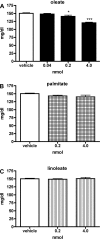Differential effects of hypothalamic long-chain fatty acid infusions on suppression of hepatic glucose production
- PMID: 20647558
- PMCID: PMC2957867
- DOI: 10.1152/ajpendo.00190.2010
Differential effects of hypothalamic long-chain fatty acid infusions on suppression of hepatic glucose production
Abstract
Our objective was to investigate whether the direct bilateral infusion of the monounsaturated fatty acid (MUFA) oleic acid (OA) within the mediobasal hypothalamus (MBH) is sufficient to reproduce the effect of administration of OA (30 nmol) in the third cerebral ventricle, which inhibits glucose production (GP) in rats. We used the pancreatic basal insulin clamp technique (plasma insulin ∼20 mU/ml) in combination with tracer dilution methodology to compare the effect of MBH OA on GP to that of a saturated fatty acid (SFA), palmitic acid (PA), and a polyunsaturated fatty acid (PUFA), linoleic acid (LA). The MBH infusion of 200 but not 40 pmol of OA was sufficient to markedly inhibit GP (by 61% from 12.6 ± 0.6 to 5.1 ± 1.6 mg·kg(-1)·min(-1)) such that exogenous glucose had to be infused at the rate of 6.0 ± 1.2 mg·kg(-1)·min(-1) to prevent hypoglycemia. MBH infusion of PA also caused a significant decrease in GP, but only at a total dose of 4 nmol (GP 5.8 ± 1.6 mg·kg(-1)·min(-1)). Finally, MBH LA at a total dose of 0.2 and 4 nmol failed to modify GP compared with rats receiving MBH vehicle. Increased availability of OA within the MBH is sufficient to markedly inhibit GP. LA does not share the effect of OA, whereas PA can reproduce the potent effect of OA on GP, but only at a higher dose. It remains to be determined whether SFAs need to be converted to MUFAs to exert this effect or whether they activate a separate signaling pathway to inhibit GP.
Figures




References
-
- Barre DE. The role of consumption of alpha-linolenic, eicosapentaenoic and docosahexaenoic acids in human metabolic syndrome and type 2 diabetes—a mini-review. J Oleo Sci 56: 319– 325, 2007 - PubMed
-
- Boden G, She P, Mozzoli M, Cheung P, Gumireddy K, Reddy P, Xiang X, Luo Z, Ruderman N. Free fatty acids produce insulin resistance and activate the proinflammatory nuclear factor-kappaB pathway in rat liver. Diabetes 54: 3458– 3465, 2005 - PubMed
-
- Bragt MC, Popeijus HE. Peroxisome proliferator-activated receptors and the metabolic syndrome. Physiol Behav 94: 187– 197, 2008 - PubMed
-
- Browning LM, Jebb SA. Nutritional influences on inflammation and type 2 diabetes risk. Diabetes Technol Ther 8: 45– 54, 2006 - PubMed
Publication types
MeSH terms
Substances
Grants and funding
LinkOut - more resources
Full Text Sources
Other Literature Sources
Research Materials
Miscellaneous

